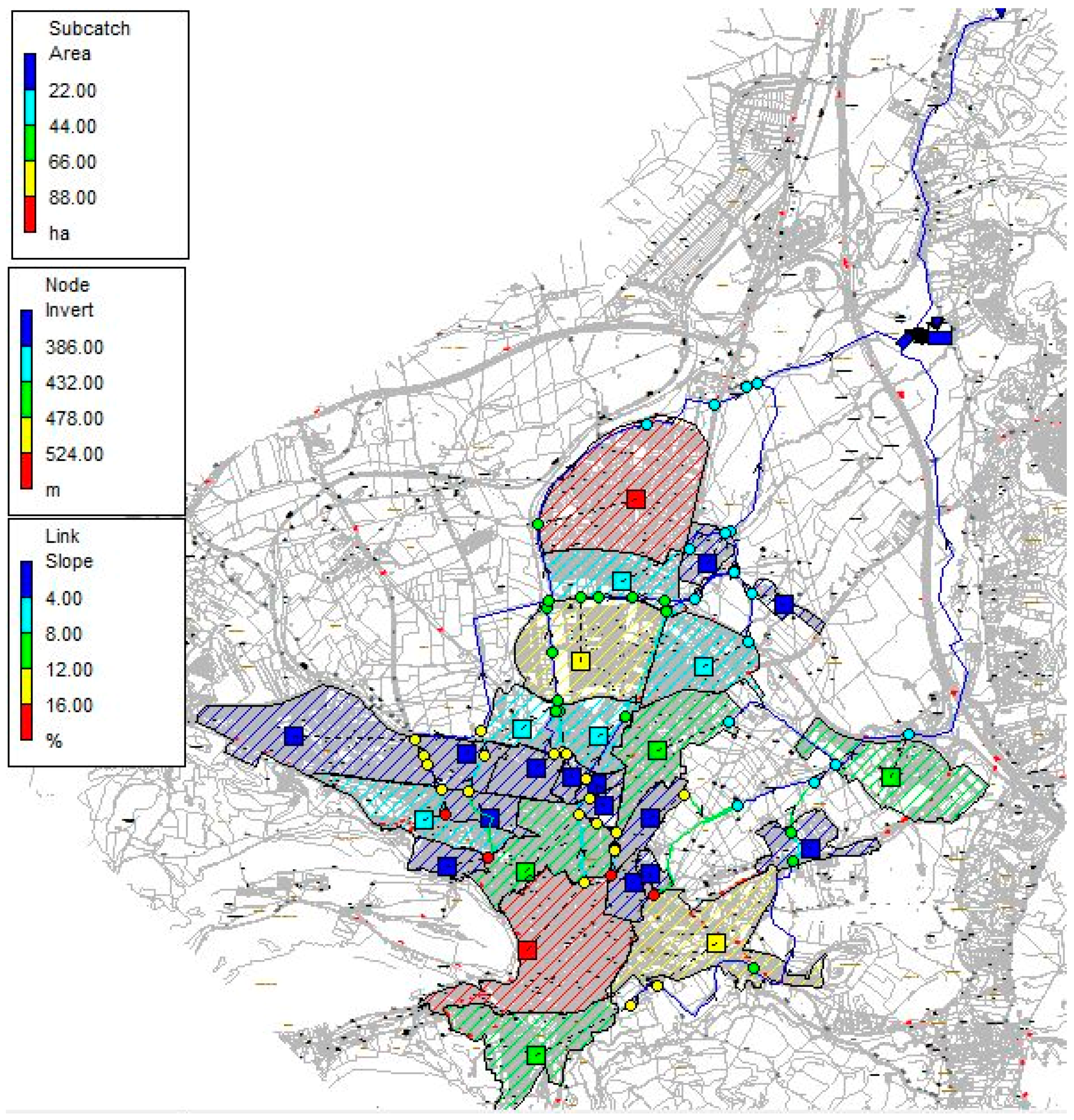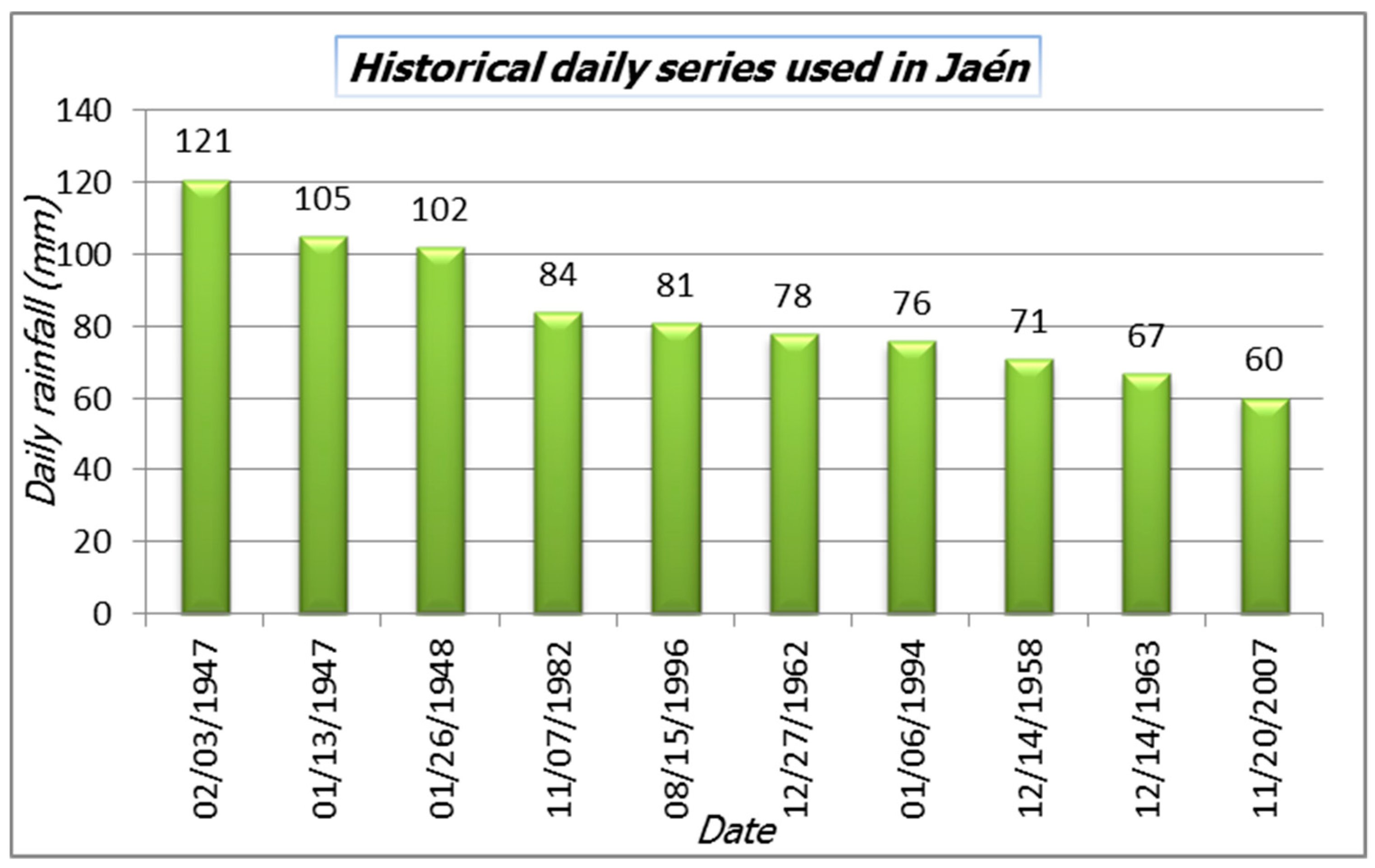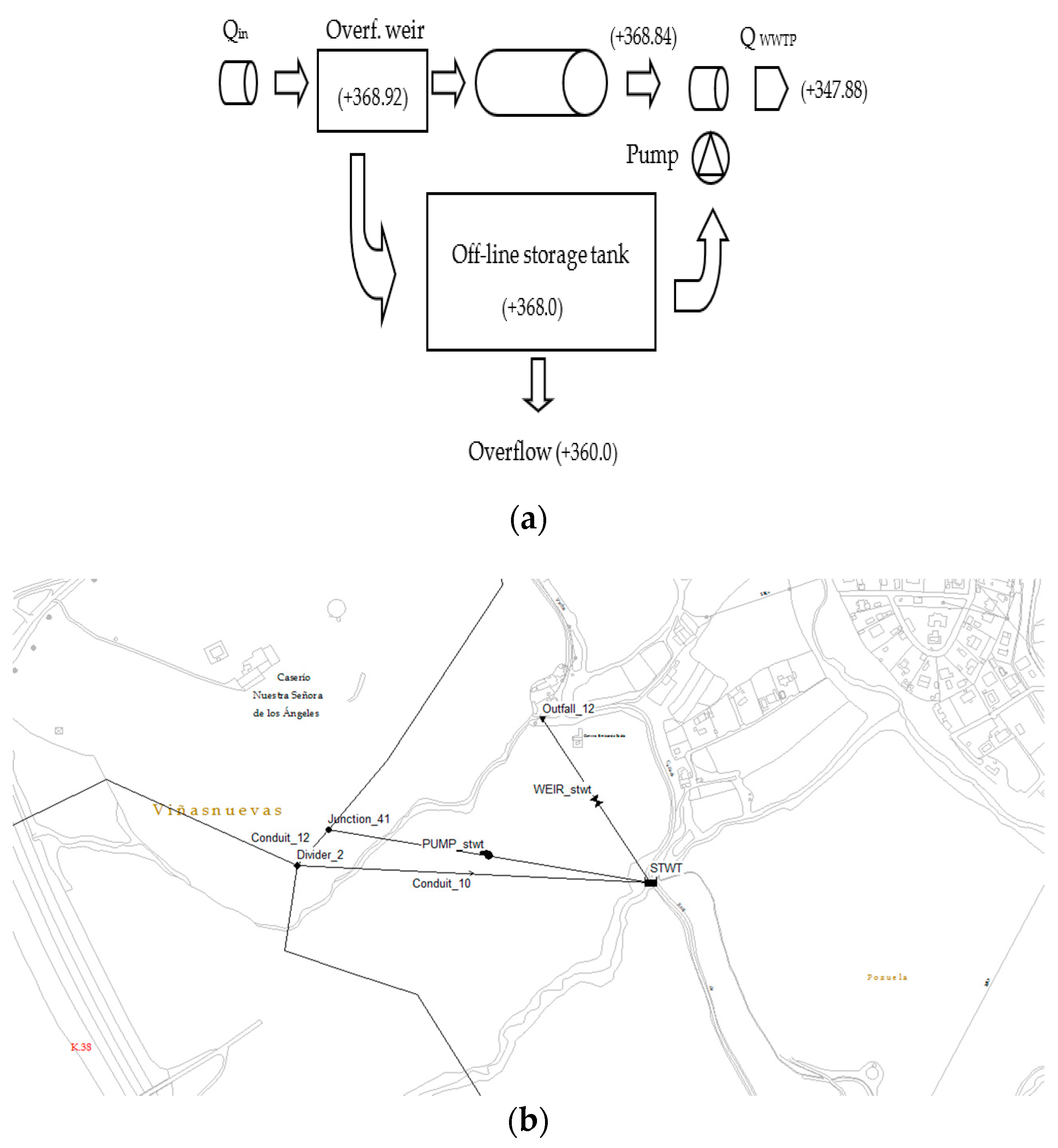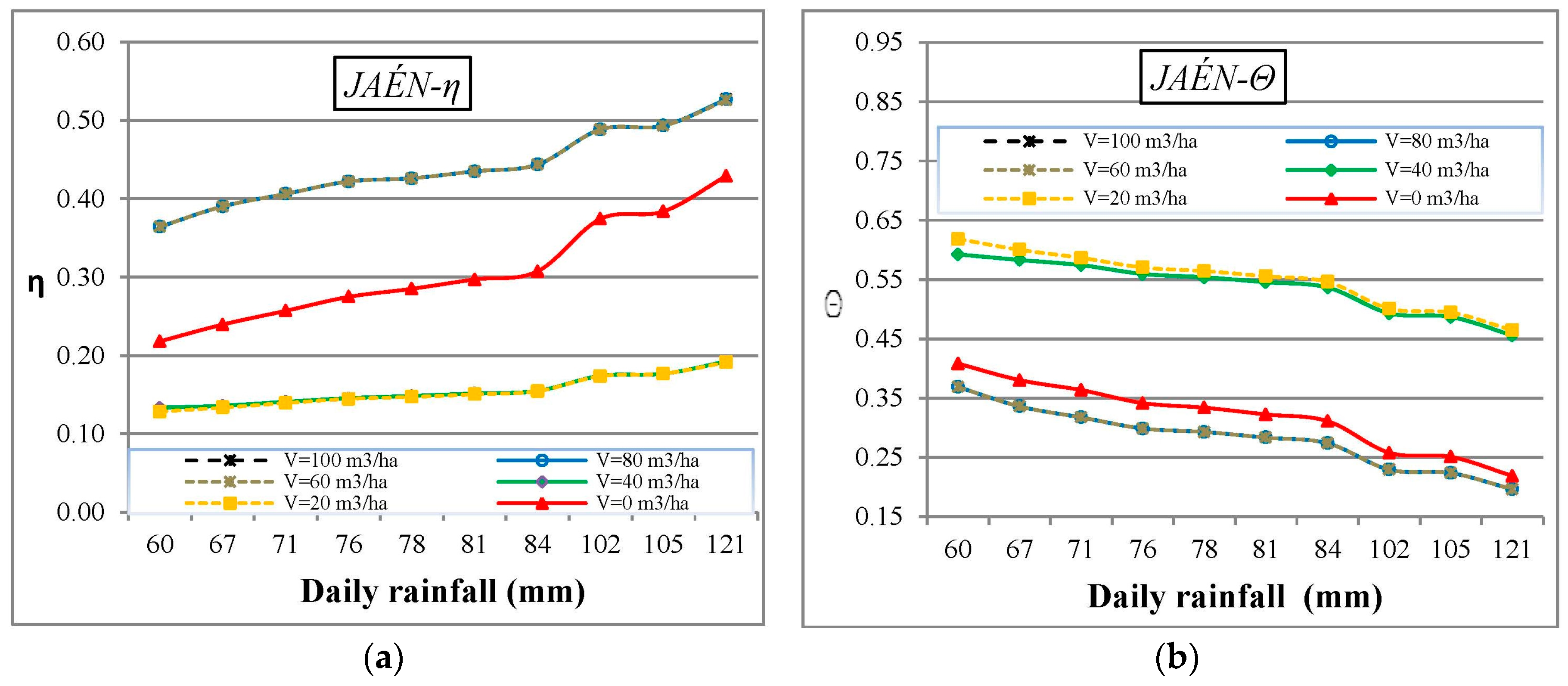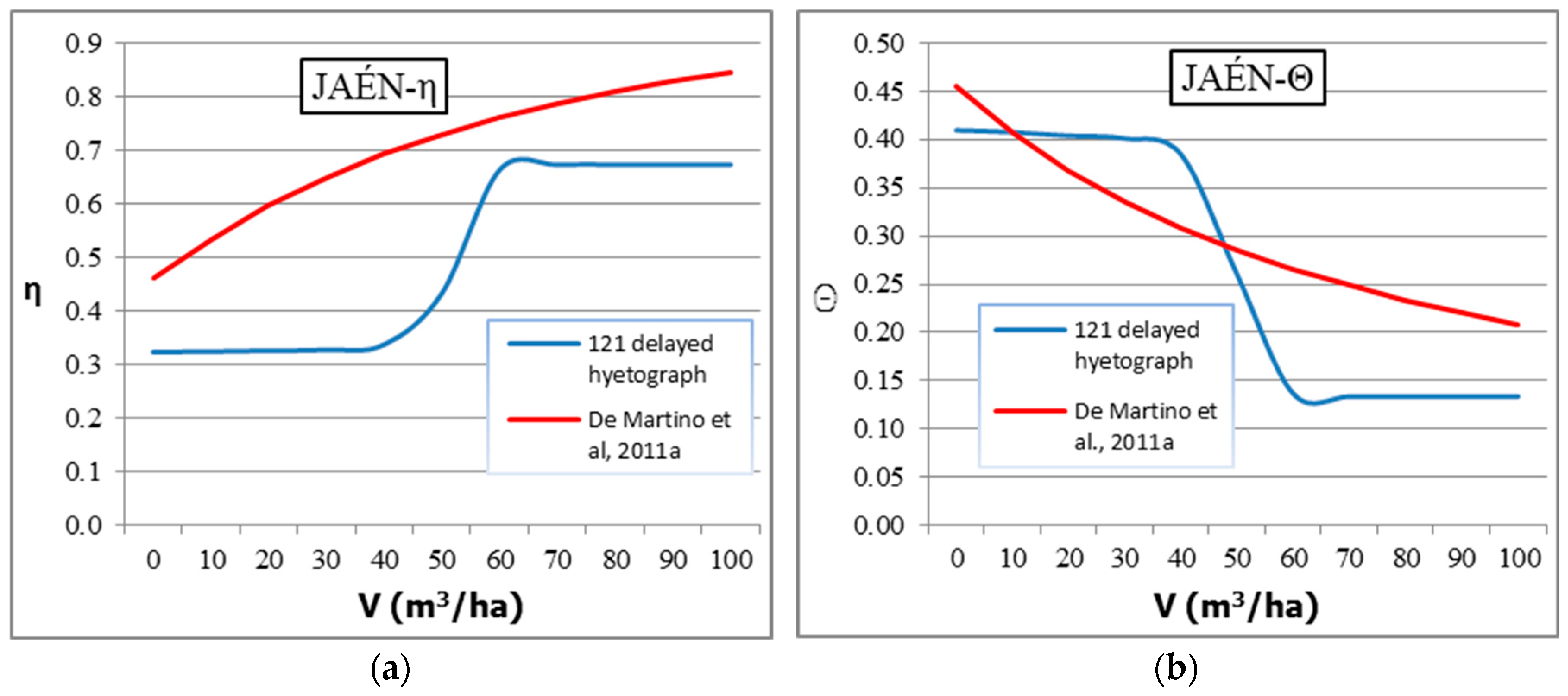2.2. SWMM Modelling
To quantify the effects of combined sewer overflows (CSOs), it was necessary to develop a rainfall runoff model. To this end, some models based upon studies on artificial intelligence have recently emerged, such as support vector machines (SVMs). For example, Granata et al. (2016) [
21] developed a comparative study of rainfall runoff between support vector regression (SVR, a variant of SVM) and the United States Environmental Protection Agency (EPA)’s storm water management model (SWMM). Considering that this research obtained comparable performances for the models, and that the application of SVMs is beyond the scope of our research, this paper presents the results of extensive continuous numerical simulations, performed using the software package storm water management model (SWMM v5.1) [
22] to analyse the present sewer system in Jaén. The features of the resulting model are displayed in
Table 2.
Graphical information of the study area is also provided in
Figure 1.
The main features of the studied catchment are shown in
Table 3.
In
Table 3, Imp Surf. is the Impermeable Surface of the catchment, d
p-perv and d
p-imp are the maximum levels of depression storage of pervious and impervious areas respectively, and n
perv and n
imp are the corresponding Manning coefficients.
Regarding the maximum depression storage coefficient, the reference values from the SWMM user manual (2005) [
23] and Rossman (2015) [
22] were applied. The assumption that pervious areas are similar to “Pasture”, in most cases, undeveloped surfaces within urban areas, was adopted. The Manning coefficients for surface runoff were taken from reference values indicated in GMMF (2005) [
23] and Rossman (2015) [
22], and impervious surfaces were deemed to be equivalent to “smooth asphalt”, whereas permeable surfaces were considered to be similar to “range (natural)”.
On the other hand, flow routing (water flow through sewer pipes represented in SWMM), is governed by the momentum and the conservation of mass equations (i.e., the Saint Venant equations). These equations were solved by applying the dynamic wave routing method. In addition, the water depth within pipes was estimated using the Manning equation. Meanwhile, infiltration was modelled through the Soil Conservation Service (SCS) Curve Number method.
Overflow pollution was calculated with reference to the mass and concentration of the total suspended solids (TSS), since they are strictly correlated with other common urban pollutants (such as Biochemical Oxygen Demand in five days (BOD5), Chemical Oxygen Demand (COD), and heavy metals), as shown, for example, by Gupta and Saul (1996) [
14]. Hogland et al. (1984) [
24] also reported that a large proportion of other pollutants, such as nutrients, heavy metals, COD, and organic compounds, may be associated with the presence of sewer solids in wastewater through adsorption/absorption processes. They concluded that up to 90% of the total phosphorus and organic matter (COD) discharged via stormflow may originate from resuspended pipe deposits. Other authors [
25] have shown that the variation in suspended solids, chemical oxygen demand, and orthophosphates, follows a similar pattern, whilst Verbanck et al. (1994) [
26] confirmed that heavy metals and organic pollutants are primarily associated with the finest particulates. Sartor and Boyd (1972) [
27] obtained a clear correlation between the TSS concentration and other pollution parameters (BOD5, COD, and heavy metals). Consequently, in this paper, TSS was used to quantify discharged pollution.
The power function described by Rossman (2015) [
22] was, accordingly, used to model the accumulation (B) of TSS (mass per unit area):
where
t is the preceding dry weather,
C1 is the maximum possible build-up (mass per unit area),
C2 is the build-up rate constant (day
−1), and
C3 is the time exponent. Furthermore, pollutant wash-off occurs during wet weather periods, and is described through exponential wash-off, which was also described by Rossman (2015) [
22], as follows:
where
W is the wash-off load in units of mass per hour,
E1 is the wash-off coefficient,
E2 is the wash-off exponent,
q is the runoff rate per unit area (mm/h), and
B is the TSS build-up (mass per unit area).
In order to establish the above coefficients, the values applied by Hossain et al. (2010) [
28] and displayed in
Table 4 were used.
Numerical simulations can be performed with design hyetographs obtained from either particular episodes of rain or from any other procedure that generates synthetic hyetographs [
16].
Calibrating SWMM model parameters is an intensive task because of both the size and complexity of the studied catchment. Accordingly, in order to carry out this calibration process, Barco et al. (2008) [
29], used a geographic information system (GIS) to process the input data and generate the spatial distribution of precipitation. In addition, the complex method was applied to estimate runoff parameters. The parameters that were shown to be the most sensitive to the impervious surface and the depression storage of impervious areas, and least sensitive to the Manning coefficient, were used in the model.
The above research could have been applied to calibrate our SWMM model. However, as the necessary information for the development of a GIS was unavailable, the bibliography was used to determine the value of the parameters of the SWMM model. In this paper, a procedure was used to obtain design hyetographs from IDF curves. Although it could be applied using any IDF curve, the simple model proposed by Témez (1978) [
30], which uses the intensity of rainfall, duration of rainfall, and return period, was used here. This model also takes the geographical situation of the system into account.
where I
t (mm/h) is the average rainfall intensity corresponding to the interval of duration t; I
d (mm/h) is the daily average rainfall intensity corresponding to the return period considered (I
d = P
d/24); P
d (mm) is the maximum daily rainfall corresponding to the return period considered; I
1 (mm/h) is the hourly rainfall intensity corresponding to the return period considered. The value of the parameter I
1/I
d depends on the site; a value of I
1/I
d = 9 is considered here. t (h) is the duration of the interval to which I
t relates.
By applying the above expression for durations of between 1 and 24 h, an intensity level was obtained for each duration value and, from this, the amount of rainfall was determined. The intensity value for each time interval was then obtained as the difference between the rainfall during a storm’s duration at the beginning of the interval minus the rainfall during a storm’s duration until the previous interval. Thus, the intensity at hour 5, for example, would represent the rainfall of a 5 h storm (I
5·5), minus the rainfall of a 4 h storm (I
4·4). In this way, starting from the Témez (1978) [
30] model, the hourly temporal distribution was obtained.
Precipitation time data were requested from the Spanish Meteorological Agency ([
20]) at weather station 5270B in Jaén.
Figure 2 shows the logs used in the model of Jaén. The logs displayed match the daily rain values, with hourly logs only being available from 2001.
The value of the daily average intensity of rainfall (Id) was subsequently adjusted so that the total daily rainfall corresponded with the registered values. Finally, once the intensity values above 24 h had been estimated, it was possible to reorder them to obtain advanced, delayed, or symmetrical (stepped, centred with alternate hourly steps) hyetographs. It is worth acknowledging that delayed hyetographs (precipitation values sorted in ascending order) produce the least efficient results; this method was selected to define the shape of the storm design.
Simulations were performed on the combined sewer of Jaén according to the common typology of Spanish sewer systems. Calculations for the sanitary flow in the combined sewer were performed by assuming an average dry weather flow, Qdw, obtained through the adoption of a total allocation of 250 litres per inhabitant per day. According to current practice in Spanish sewer systems, the maximum flow conveyed to the treatment plant (Qm) was assumed to be Qm = 5 Qdw. Given that an ideal divider was assumed in the simulations, a constant cut-off flow was considered as the inflow varied.
In this paper, the performance of an offline storage tank was analysed. To do this, an ideal facility was provided just upstream of the current WWTP, as shown in the upper right corner of
Figure 1. The tank volume ranged with the impervious surface of the catchment (impervious hectare, ha
imp) from 0 m
3/ha
imp to 100 m
3/ha
imp, and it was assumed that there was a perfect combination of pollutants in the tank at every time step. The operating scheme of the stormwater tank is sketched in
Figure 3.
An offline tank starts filling when the inflow discharge exceeds the divider cut-off flow (Cc × Qdw, Cc coefficient of proportionality). When the tank is full, a weir diverts the excess discharge into the receiver. The tank is drained by means of a pumping system after the rainfall has ceased, and the wastewater is conveyed to the treatment plant. The pumping flow for the stormwater sewer is Cc × Qdw. Given that the maximum wastewater flow conveyed to the treatment plant is Cc × Qdw, and the peak hourly coefficient for sanitary flow for the combined sewer is approximately 2, the pumping flow draining the tank is (Cc − 2) × Qdw.
In order to compare the different design configurations and operating conditions of stormwater detention tanks (SWDTs), Todeschini et al. (2012) [
5] described the performance indexes (PIs) that can be applied, inter alia, to individual events, as follows:
The maximum concentration of pollutants in the overflow;
The duration of overflow/the duration of stormwater runoff;
The pollutant mass captured/the pollutant mass in the stormwater runoff;
The volume sent to the wastewater treatment plant/the volume of stormwater runoff;
The SWDT emptying time.
Calabrò and Viviani (2006) [
9] evaluated the behaviour of detention tanks using similar PIs, namely, the efficiency (calculated as the ratio between the total mass of TSS entrapped in the tank and the total mass washed off during a single event), number, duration, concentration, flow, and mass discharge. Furthermore, Anta et al. (2007) [
31] estimated the effect of the size of online and offline tanks while considering both the number of CSO events and the percentage of spilled runoff.
In our research, in order to evaluate the responses of sewer systems to different storms, the following efficiency indices, described by De Martino et al. [
11] and [
12], were determined:
The pollution load removal rate,
η, is defined as
where
Mr is the TSS mass flowing into the receiver and
Mc is the total mass accumulated in the catchment.
The receiver overflow rate,
θ, is defined as
where
Wr is the water volume discharged into the receiver, and
Wc is the total rainfall volume in the catchment. Low values of
η and high values of
θ implicate that a greater water mass and volume is being transferred to the receiver, thereby leading to a more unfavourable operation of the sewer systems.
